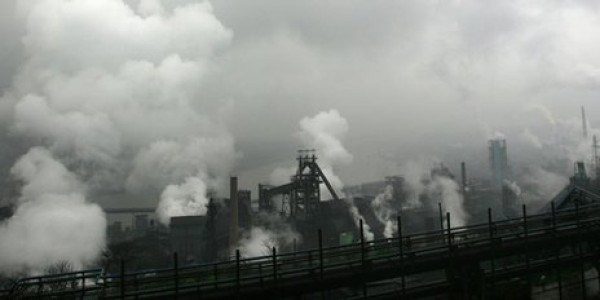By Puneet Pal Singh Business Reporter, BBC News China’s rapid industrialization has contributed to the rising pollution levels in the country Over the past few years China has earned itself quite a few crowns in the “world’s-biggest” category. It has become the world’s biggest internet market, largest car market, biggest exporter… the list goes on and on. While Beijing takes a lot of pride in some of these achievements, there is one title that it wants to let go of sooner rather than later, that of being the world’s biggest polluter. And in an attempt to do so, China has launched a pilot project of its first ever carbon trading scheme in Shenzhen. “This is definitely a big game-changer for China,” says Winnie Tang, a director with Kind Resources, an investment and deal advisory firm which focuses on carbon emission reduction. “It is a clear indication that they are serious about reducing emissions and bringing down pollution levels.” ‘Market-based policy’ Under carbon trading, firms are given credits – each equal to one tonne of carbon emissions. There is a cap on the credits issued to ensure that firms keep their emissions under control. “It is still a very new concept to the Chinese firms. They have little experience in recording their emissions and trading carbon credits” The companies are required to measure and report their carbon emissions and to hand in one allowance for each tonne of carbon they release. If companies emit less carbon than their allowance, they can trade their credits. On the other hand, if their emission levels exceed the limit, they have to buy fresh credits – thus putting a price on pollution. “It is a market-based policy. If someone emits more – they have to pay for it,” says Princeton Peng, chief executive of Climate Bridge, a firm specialising in carbon trading and offset project development. Mr Peng says this is likely to force companies to implement policies aimed at bringing down their emission levels and as a result help reduce overall pollution. China’s carbon trading scheme pilot projects Location Companies trading emissions Emissions covered SOURCE:CARBON MARKET WATCH Beijing 420 – 600 50% Shanghai 197 50% Tianjin 120 60% Chongqing NA NA Shenzhen 635 40% Guangdong 830 42% – 50% Hubei NA 35% European lesson? However, there are also concerns in China about what will happen to the price of credits when companies start to trade them. Some say that the price of these credits will rise as China looks to cut pollution levels, which may spark speculative trades. An excessive movement in the pricing of credits, on either side, could be detrimental to the overall objective of the scheme. “If the price goes too high, it will severely impact the operations of the companies,” says Mr Peng of Climate Bridge. Carbon emissions in China – key milestones 2006: Preliminary plan for nationwide emission trading scheme outlined 2008: Environment and energy exchanges established in Beijing, Shanghai and Tianjin 2010: 12th five-year plan lists carbon markets as key measure for reducing carbon and energy intensities 2011: Seven carbon trading pilots announced 2013: Shenzhen pilot starts Source: Climate Bridge “On the other hand, if the market price is too low – there is no incentive for people to reduce emission and invest in clean energy solutions.” These concerns stem in part from the developments in the European Union’s carbon trading market – currently the world’s biggest. The European Union (EU) market has seen the price of credits falling to $4 per tonne in recent weeks, from $40 per tonne a few years ago. Analysts blame the sharp decline on two key issues. They say that the rise in prices after the launch of the scheme in 2008 was triggered in part by traders who speculated that the carbon prices would keep rising. At the same time, they argue that authorities issued excessive amounts of credits which narrowed the demand-and-supply gap. That coupled with an overall slowdown in the EU economy resulted in the price of the credits falling and raised concerns about the future of the scheme. However, analysts say that Beijing has had the opportunity to learn from the developments in the EU and has fine-tuned its scheme. “No one really knows what is going to happen with the China market, but they have done their research on what the EU got wrong and are less likely to make those mistakes,” says Ms Tang. ‘Learning process’ The pilot in Shenzen is the first of seven such projects that will be launched in China over the next few months. Beijing plans to eventually launch a nationwide carbon trading scheme by 2015-16. Analysts say that by piloting the scheme across different areas, China is looking to ensure that it can tackle any teething issues and iron them out before the country-wide launch. “This will be a learning process both for the government and companies,” says Yue-tan David Tang, secretary of the board of Tianjin Climate Exchange. “The companies will have to learn how to take part in the emissions market. “The government will have the time and the opportunity to improve upon emission data infrastructure – which includes the quality of data collected and how it is collected,” he explains. Mr Tang adds that there is political will in China to get the scheme rolling and the success of the pilot programmes will only strengthen that commitment. When launched nationwide, the scheme is likely see China emerge as the world’s biggest carbon trading market. And if that helps to bring down pollution levels substantially, it will be one crown that Beijing will wear with pride. Taylor Scott International
Can China Achieve Success With Carbon Trading Scheme?

This entry was posted in Investment, investments, News, Property, Taylor Scott International, TSI, Uk and tagged carbon, china, chinese, country, environment, government, news, pollution, price. Bookmark the permalink.







